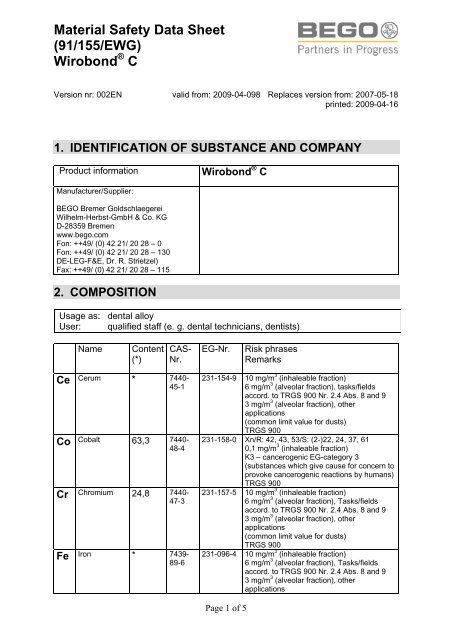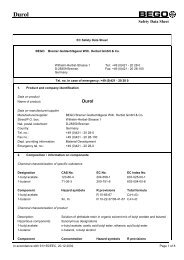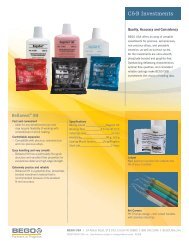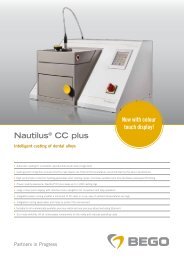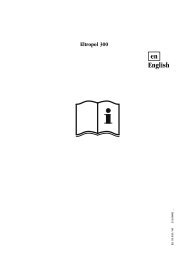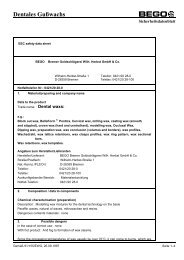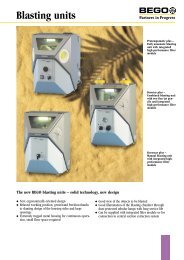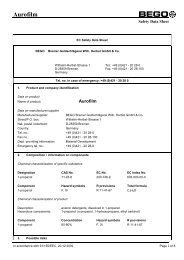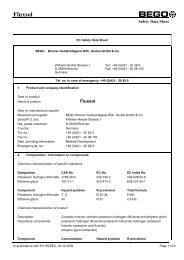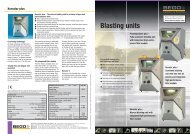Material Safety Data Sheet (91/155/EWG) Wirobond C - m-tec dental
Material Safety Data Sheet (91/155/EWG) Wirobond C - m-tec dental
Material Safety Data Sheet (91/155/EWG) Wirobond C - m-tec dental
Create successful ePaper yourself
Turn your PDF publications into a flip-book with our unique Google optimized e-Paper software.
<strong>Material</strong> <strong>Safety</strong> <strong>Data</strong> <strong>Sheet</strong>(<strong>91</strong>/<strong>155</strong>/<strong>EWG</strong>)<strong>Wirobond</strong> ® CVersion nr: 002EN valid from: 2009-04-098 Replaces version from: 2007-05-18printed: 2009-04-161. IDENTIFICATION OF SUBSTANCE AND COMPANYProduct information<strong>Wirobond</strong> ® CManufacturer/Supplier:BEGO Bremer GoldschlaegereiWilhelm-Herbst-GmbH & Co. KGD-28359 Bremenwww.bego.comFon: ++49/ (0) 42 21/ 20 28 – 0Fon: ++49/ (0) 42 21/ 20 28 – 130DE-LEG-F&E, Dr. R. Strietzel)Fax: ++49/ (0) 42 21/ 20 28 – 1152. COMPOSITIONUsage as: <strong>dental</strong> alloyUser: qualified staff (e. g. <strong>dental</strong> <strong>tec</strong>hnicians, dentists)NameContent(*)CAS-Nr.EG-Nr.Risk phrasesRemarksCe Cerum * 7440-45-1Co Cobalt 63,3 7440-48-4Cr Chromium 24,8 7440-47-3Fe Iron * 7439-89-6231-154-9 10 mg/m 3 (inhaleable fraction)6 mg/m 3 (alveolar fraction), tasks/fieldsaccord. to TRGS 900 Nr. 2.4 Abs. 8 and 93 mg/m 3 (alveolar fraction), otherapplications(common limit value for dusts)TRGS 900231-158-0 Xn/R: 42, 43, 53/S: (2-)22, 24, 37, 610,1 mg/m 3 (inhaleable fraction)K3 – cancerogenic EG-category 3(substances which give cause for concern toprovoke cancerogenic reactions by humans)TRGS 900231-157-5 10 mg/m 3 (inhaleable fraction)6 mg/m 3 (alveolar fraction), Tasks/fieldsaccord. to TRGS 900 Nr. 2.4 Abs. 8 and 93 mg/m 3 (alveolar fraction), otherapplications(common limit value for dusts)TRGS 900231-096-4 10 mg/m 3 (inhaleable fraction)6 mg/m 3 (alveolar fraction), Tasks/fieldsaccord. to TRGS 900 Nr. 2.4 Abs. 8 and 93 mg/m 3 (alveolar fraction), otherapplicationsPage 1 of 5
<strong>Material</strong> <strong>Safety</strong> <strong>Data</strong> <strong>Sheet</strong>(<strong>91</strong>/<strong>155</strong>/<strong>EWG</strong>)<strong>Wirobond</strong> ® CVersion nr: 002EN valid from: 2009-04-098 Replaces version from: 2007-05-18printed: 2009-04-16Mo Molybdenum 5,1 7439-98-7Si Silicon * 7440-21-3W Tungsten 5,3 7440-33-7(common limit value for dusts)TRGS 900231-107-2 10 mg/m 3 (inhaleable fraction)6 mg/m 3 (alveolar fraction), Tasks/fieldsaccord. to TRGS 900 Nr. 2.4 Abs. 8 and 93 mg/m 3 (alveolar fraction), otherapplications(common limit value for dusts)TRGS 900215-609-9 10 mg/m 3 (inhaleable fraction)6 mg/m 3 (alveolar fraction), Tasks/fieldsaccord. to TRGS 900 Nr. 2.4 Abs. 8 and 93 mg/m 3 (alveolar fraction), otherapplications(common limit value for dusts)TRGS 900231-113-5 5 mg/m 3 (inhaleable fraction)TRGS 900* = contents less than 1 mass percent in <strong>Wirobond</strong> ® CThe given information are not valid for the alloy but only for vapours, smokes anddusts which may formed during the processing.3. HAZARD IDENTIFICATIONBy appropriate appliance and regarding the recommendations of the work hygiene itis improbable that <strong>Wirobond</strong> ® C exhibits a health risk.Due to the processing process dusts, fumes and smokes are emerged, which shallnot be inhaled. Therefore sufficient exhaustion for dusts, fumes and smokes shall beused.In specific cases allergic reaction may occur.NFPA ratings for USA (scale 0-4)Health = 0Fire = 0Reactivity = 0HMIS ratingHealth = *0Fire = 0Reactivity = 0Page 2 of 5
<strong>Material</strong> <strong>Safety</strong> <strong>Data</strong> <strong>Sheet</strong>(<strong>91</strong>/<strong>155</strong>/<strong>EWG</strong>)<strong>Wirobond</strong> ® CVersion nr: 002EN valid from: 2009-04-098 Replaces version from: 2007-05-18printed: 2009-04-164. FIRST AID MEASURESIf dusts, fumes or smokes were inhaled sufficient fresh air should be provided. Ifapplicable a doctor should be consulted.In case of eye contact it should be rinsed thoroughly several minutes under runningwater. If applicable a doctor should be consulted.If swallowed a doctor should be consulted.5. FIRE FIGHTING MEASURESThe material is inflammable and not oxidizing. In case of large quantities of dust thedanger of dust an explosion is given.Toxic reaction products may occur by high temperatures.All extinguishing agents are suitable. Favourable are sodium chloride, dry sand6. ACCIDENTAL RELEASE MEASURESNo personal precautionsContaminations should be picked up mechanically7. HANDLING AND STORAGEBy appropriate application no special measures for handling or storage arenecessary. Sufficient suction should be guaranteed.8. EXPOSURE CONTROLS AND PERSONAL PROTECTIONRespiratory pro<strong>tec</strong>tionEye pro<strong>tec</strong>tionHand pro<strong>tec</strong>tionEnsure suitable suctionIf applicable use respirator (particle filter P3 according toDIN EN 143)If applicable use safety glassesIf applicable use pro<strong>tec</strong>tive gloves (e. g. by knownallergies against one or more alloy components)Working hygiene measures The usual safety precautions for working with chemicalsubstances should be taken account of.During working to not eat, drink, smoke or snuff tobacco.Regard legal instructions for working hygieneWash face and hands before break and/or end of workPage 3 of 5
<strong>Material</strong> <strong>Safety</strong> <strong>Data</strong> <strong>Sheet</strong>(<strong>91</strong>/<strong>155</strong>/<strong>EWG</strong>)<strong>Wirobond</strong> ® CVersion nr: 002EN valid from: 2009-04-098 Replaces version from: 2007-05-18printed: 2009-04-169. PHYSIAL AND CHEMICAL PROPERTIESForm - cylinderColour - silverOdourodourlessMelting intervall °C 1370-1420Inflammable - noOxidizing properties - noDensity g/cm³ 8,510. STABILITY AND REACTIVITYIn case of contact with acids the formation of hydrogen is possible.Dusts due to processing processes (e. g. casting, grinding) may cause in extremecases dust explosions.11. TOXICOLOGICAL INFORMATIONNo dangerous reactions are known to occur with correct handling and storage.12. ECOLOGICAL INFORMATIONNormally chemical substances, which accumulate as residual material, are specialrefuses. The removal is defined by legal waste management laws and correspondingregulations. In case of doubt contact the public authorities.Prevent penetration into soil, water and drainage systems.13. DISPOSAL CONSIDERATIONSResidual material should be recycled. Disposal according to local authorityregulationsUsed packaging may also be disposed according to local authority regulations14. TRANSPORT INFORMATIONDental alloys are no hazardous materials in the sense of transport regulations(GGVS/GGV E/RID/ADR/IMDG-Code/ICAO-TI).Page 4 of 5
<strong>Material</strong> <strong>Safety</strong> <strong>Data</strong> <strong>Sheet</strong>(<strong>91</strong>/<strong>155</strong>/<strong>EWG</strong>)<strong>Wirobond</strong> ® CVersion nr: 002EN valid from: 2009-04-098 Replaces version from: 2007-05-18printed: 2009-04-1615. RegulationsClassification according to EU directives: according to preparation directive(1999/45/EG)No classification necessaryClassification according to national directives:No classification necessary16. OTHER INFORMATIONThe information provided in this <strong>Material</strong> <strong>Safety</strong> <strong>Data</strong> <strong>Sheet</strong> (MSDS) is correct to thebest of our knowledge, information and belief at the date of its publication. Theydescribe the product in respect of safety recommendations. The given information donot cause a legal relation ship.The information given is designed only as guidance for safe handling, use,processing, storage, transportation, disposal and release and is not to be considereda warrant or quality specification. The information relates only to the specific materialdesignated and may not be valid for such material used in combination with any othermaterials or in any process, unless specified in the text.The described product is to be used exclusively for the intended use (<strong>dental</strong> alloy).This version replaces all older issues.R 11R 12R 14R 15R 17R 40R 42R 43R 53easily inflammablehighly inflammableReacts intensivly with water.Reacts with water under formation ofinflammable gasesself inflammable at airSuspicion of cancerogenityDue to inhalation sensibilisation is possibleDue to skin contact sensibilisation is possibleMay have long term effects on body waterS 17S 22S 24S 37S 61Xn:Keep away from inflammable substancesDo not inhale dustAvoid skin contactUse favourable pro<strong>tec</strong>tive glovesAvoid release in to the environmentHazardousPage 5 of 5


